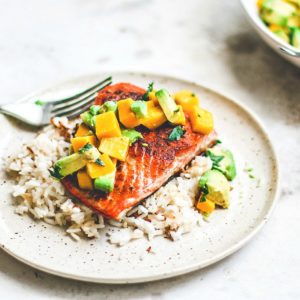This post contains affiliate links. Please see our disclosure policy.
Fresh and simple ingredients are used to dish up this crispy-skinned pan-seared salmon topped with creamy and tangy avocado and mango salsa. It’s the perfect dinner to greet Spring and Summer, and great to add to your rotation when eating fish during pregnancy.
This recipe is sponsored by Orca Bay Foods | Thanks for supporting the brands I love and trust.
Three things in life are certain: death, taxes, and receiving unsolicited advice from people when you’re pregnant.
“Should you be eating that?” A common eye roll-worthy challenge disguised as an inquiry. I’m not sure why some non-pregnant folks think they’ve done more research than an uptight Google-probing mom-to-be, but they seem to have no shame in it. Along with coffee and deli meats, fish remains a taboo food item for expecting mothers.
With that, I’ve partnered up with my seafood-loving friends at Orca Bay Foods to help set the record straight.
Table of Contents
Is eating fish during pregnancy safe?
Not only is eating fish during pregnancy safe, but it’s recommended! Concern generally comes from the mercury levels in fish—which is a legit concern. However, many people fail to realize that not all species contain harmful amounts of mercury, and incorporating a moderate amount of low mercury seafood into your diet is actually beneficial for both mom and baby. Think about all of those wonderful Omega-3 fatty acids helping a baby’s visual and cognitive development! Additionally, these same fatty acids are known to have positive effects on pregnancy itself. Sounds like a WIN to me.
How can you differentiate between what is safe and what isn’t? The FDA offers a chart to guide you through fish consumption during pregnancy. Your doctor’s office should also provide you with the same type of chart at your first prenatal appointment.
In short, 2-3 servings of fish, per week, from the “Best Choice” column is recommended. These fish include favorites like cod, baked flounder, haddock, and poached salmon, so you’re not missing out on much!
What should be avoided when eating fish during pregnancy?
Here’s where all of that concern comes from. Despite the plethora of healthy recommendations, there are indeed a few species that contain high levels of mercury and should be avoided by pregnant women completely. Luckily, the list is short.
- King Mackerel (not to be confused with North Atlantic mackerel, which is a smaller species and a good choice)
- Swordfish
- Shark
- Bigeye Tuna
- Tilefish
- Marlin
- Orange Roughy
The only real common one here is tuna, since bigeye tuna is often used at sushi restaurants. But sushi, when served raw, is another risky food that’s best to avoid due to the risk of foodborne illness and parasites. (Heartbreaking, I know. I already have my post-birth sushi takeout order ready for my husband to fetch as soon as I push the little one out. We’re going to have the most delicious and romantic hospital room sushi date ever.) If you need to fill the void, eat cooked sushi rolls, like the ones made up of shrimp or crab.
So! The next time a nosy family member or acquaintance on social media starts to interrogate your fish consumption, school them. Let them know that they no longer have to condemn anything and everything with gills—or the hungry mom-to-be eating them. Most fish are totally okay and will lend a helping hand with your unborn child’s development :)
Pan-Seared Salmon With Avocado and Mango Salsa.
Salmon has been a constant throughout my pregnancy. And because it’s so versatile, I’ve been able to incorporate other beneficial ingredients with it—like creamy avocado and tangy mangoes! This dish is a powerhouse for expecting mothers with its Omega-3 fatty acids, healthy fats, potassium, and vitamins.
I like serving mine with coconut rice or quinoa, but you can easily toss this medley into a salad or eat it on its own. And if your carb-hungry like I am, bring a bagel into the equation. I slathered a bagel with cream cheese and topped it with the leftovers from this dish for lunch the next day. It was dreamy.



If you try this recipe or create your own variation, let me know in the comments! I love connecting with you. Then snap a photo and tag me on the Insta @killing__thyme and be featured in our newsletter.

Pan-Seared Salmon With Avocado and Mango Salsa
Ingredients
- 4 4 to 6 oz fillets of salmon, skin on, I used Orca Bay Foods Alaska Sockeye Salmon
- 2 TBSP neutral oil with high smoke point, I use avocado oil or olive oil
- Kosher salt and cracked black pepper
- 1 TBSP chili powder
- 1 TBSP ground coriander
- 2 tsp cumin
Avocado and Mango Salsa.
- 1 ripened mango, cubed
- 1 large ripened avocado, cubed
- 1/4 cup chopped fresh parsley or cilantro
- 1 lime, juiced
- 1 TBSP extra virgin olive oil
- Kosher salt and cracked black pepper
Materials.
- Cast iron skillet
Instructions
- Remove salmon from fridge. Pat the fillets with a paper towel to remove excess moisture. Sprinkle each fillet with a bit of salt and cracked black pepper. In a small bowl, mix the chili powder, ground coriander, and cumin. Sprinkle the spice mixture evenly over each fillet, rubbing the seasoning into the fillets with your bare hands to coat. Set the fillets aside and let them come to room temperature. This should take about 15 minutes. (Bringing your fish to room temp will ensure an even cook throughout the fillets.)In the meantime, prepare the avocado and mango salsa.
Avocado and Mango Salsa.
- Combine the diced mango, avocado, and freshly chopped parsley or cilantro in a large bowl. Drizzle lime juice over the ingredients, then add a pinch of salt and pepper, to taste. Give the contents a good stir; set aside.
Salmon.
- Add a generous amount of your oil to your skillet — enough to coat the bottom of the pan. Heat over high heat until the oil starts to smoke a tiny bit.
- Carefully place one or two salmon fillets into the hot pan, skin-side down. (*See notes about cooking multiple fillets at once.)As soon as the fillet hits the pan, press down on it with a spatula until the fillet flattens out (this only takes seconds) while bringing the heat down to medium. Pressing the fillet keeps the skin firm against the pan and will give you crisp results without curling your fillet upward. Let your salmon cook for about 4-6 minutes, or until you can see a nice golden brown color on the edge of the skin. DO NOT touch, push, or try to budge your salmon beforehand, or you’ll tear the skin. Once you see the golden edges, carefully slide your spatula underneath the fillet and turn it over. (If it doesn’t release, give it another 30 seconds and try again.)
- Once you’ve flipped your salmon, it’s likely a little over halfway cooked so it only needs another 2-3 minutes of cooking. If you have a meat thermometer, remove the salmon once it reaches an internal temperature of 140-145º F. If you don’t have a meat thermometer, cook the fish until it’s opaque, and then go order a meat thermometer ;)
- Once the fillet is cooked, carefully remove it from the pan and set it on a plate; cover with tin foil so it stays warm. Repeat the same process for the other fillets.






